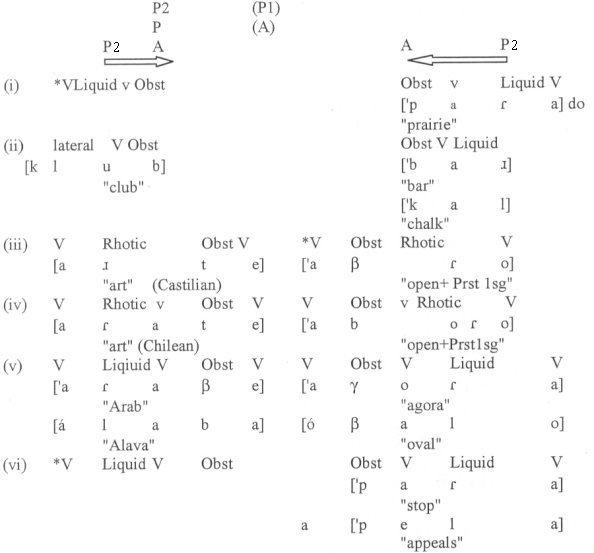
5.3 Mirror image asymmetries
In Spanish there is an intra-morphemic asymmetry with respect to the integration of the combination Obstruent-Liquid. I will refer here to the Rhotic as the Predicate P2 and the Obstruent as the Predicate P1. I will refer to the combination between these two Predicates as a Predicate-Argument relation. The Rhotic relates to the Obstruent as the Predicate in the relation, and the Obstruent relates to the Liquid as the Argument in the relation. This Predicate/Argument difference in phonological function is justified by the fact that children in their first stage on one hand articulate P1 followed by the Vowel, [p+a], skipping the svarabhakti and the Rhotic, while on the other hand they do articulate the Rhotic when intervocalic [aRa] (Miras Fernández 1992). A Rhotic is in developmental stages a Secondary predicate (P2), like some Predicates are in syntax, with respect to the Primary predicates (P1) when they combine together. Thus in I "have to eat" the action Eating is perceived as primary P1. This action may be the Argument of a modification P2 made by a modality: a "having to do something": P2 (P1). The child is initially articulating the Action I "eat" P1(A) and later the modality of the action: I "have" to eat : P2(P1(A)).
| (9) | Liquid -Obstruent Combination |
 |
When Rhoticity integrates "following" Obstruency intramorphemically, this sequence can only be possible if there is an intervening Vocoid (9i,ii,iv,v,vi) but not otherwise (9iii). This Vocoid is either a differentiated Vowel (9ii,v,vi) or it is not a differentiated Vocoid (9i,iv). When Rhotic integrates "preceding" Obstruency, this sequence can be possible if a Vocoid is present (9ii,iv,v) or if it is not present (9iii). This Vocoid can only be the differentiated one (9ii,v) but not the undifferentiated one (9i) unlike in its mirror image. The undifferentiated vocoid agrees with a preceding or a following Vocoid. The asymmetry observed is that the combinatorial needs of Obstruency can "stretch" fordwardly when its integration with a Vowel is forward but cannot "stretch" backwardly when is integration with a Vowel is backwards. This forward stretching can be expanded as long as there is a svarabhakti inter-fixation which, through a Rhotic, leeds Obstruency to the Vowel. Forward integration in a Obstruent is in Spanish independently more stretchable than backward integration since a Glide can occur in between the Obstruent and the following Vowel but not in between the Obstruent and the preceding Vowel: ObstGV [bjen] "good" vs *VGObst. The preceding svarabhakti of a Rhotic subserves the forward integration of the Obstruent. This co-operation is used to create meaning in Spanish: cf (9i) vs (9vi), while meaning is not associated with a following svarabhakti of a Rhotic (9iii,iv).1 I will refer to this asymmetry of the Obstruent and the svarabhakti as P1-P3-P2 asymmetry in the following discussion. P3, in Spanish, sequences in time with an Obstruent before (T-) and a Rhotic after ( T+).
| (10) | Spanish P1-P3-P2 asymmetry: P1 "stretchable forwardly" to A |
 |
The intra-morphemic phonological asymmetry of P1-P3 represented as in (10) is used as a mechanism to integrate fordwardly the vocoidal agreement of the Conjugation Class (P3), between the Sonorant of the base and the Sonorant-Rhotic of the Posterity morpheme (P2) (8iib). The Presence of P3 always co-occurs with the presence of A (cf.9i,5).
Any theory has to account for how, when and where plasticity and rigidity effects affecting the Vocoid of a single morpheme are regulated (5.2.1; 5.2.2.1). It also has to account for how asymmetry effects affecting the presence of the non-intramorphemic svarabhakti are regulated (5.2.2.2; 5.3).
1 Spectrographic evidence of the presence of an agreeing svarabhakti utterance
final and interconsonantally after the Rhotic has been provided to me by P.O'Neill.
Volumen 22 (2005) ISSN: 1139-8736 |